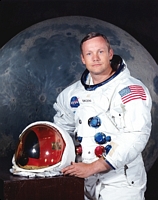|
|

|
Neil Alden Armstrong
Astronaut
|
Born: August 5, 1930
Birth Place: Wapakoneta, Ohio
Date Joined NASA: September 17, 1962
Year Left NASA: 1970
Space Flights: 2
Time in Space: 8.58 days
Number of EVAs: 2
Total EVA Time: 2.97 hours
|

Neil Armstrong
|
MISSION ASSIGNMENTS
- Gemini 5
Assignment: Backup Crew
- Gemini 8
Assignment: Prime Crew
Flight Duration: 0.45 days
- Gemini 11
Assignment: Backup Crew
- Apollo 8
Assignment: Backup Crew
- Apollo 11
Assignment: Prime Crew
Flight Duration: 8.14 days
HIGHLIGHTS
-
Armstrong attended Purdue University and earned a
Bachelor of Science degree in aeronautical engineering
in 1955. The Korean War interrupted his education when
he went to fly 78 combat missions F9F-2 jet fighters.
He was awarded the Air Medal and two Gold Stars. After
the war he continued his education at the University of
Southern California, where he earned a Master of Science
Degree in aerospace engineering.
-
Joined the NACA (National Advisory Committee for
Areonautics, later became NASA) in 1955. He transfered
to the NACA's High Speed Flight Station at Edwards Air
Force Base (now NASA's Dryden Flight Research Center)
later that year. He served as a aeronautical research
scientist and pilot.
-
As a research pilot Armstrong flew the F-100A and F-100C,
the F-101, and the F-104A. Other planes he flew included
the X-1B, X-5, F-105, F-106, B-47, KC-135, and Paresev.
He had a total of over 2450 flying hours by the time he
left Dryden.
-
Before it was cancelled Armstrong was a member of the
USAF-NASA Dyna-Soar Pilot Consultant Group. He studied
the X-20 Dyna-Soar approaches and abort maneuvers using
F-102A and F5D aircraft.
-
Armstrong was a part of the X-15 program from the
beginning and was involved in both the piloting and
engineering aspects. He made seven flights in the X-15
rocket plane between December 1960 and July 1962. He
reached the altitude of 207,500 feet and the speed of
3,989 (Mach 4).
-
After being selected in the second group of NASA
astronauts in 1962, his first space flight was aboard
Gemini 8 with Dave Scott. Gemini 8 conducted the first
ever docking in space, but shortly afterwards the
spacecraft began spinning out of control. Undocking from
the Agena target only made the spinning worse and the
spinning was nearing the point where the astronauts
might pass out. Armstrong decided to shut down the
reaction control thrusters and regain control using a
second set of thrusters only intended for re-entry. This
required that the mission be cut short and they splashed
down in the contingency recovery zone in the western
Pacific Ocean. It was Armstrongs actions that prevented
his and Dave Scott's deaths... and ultimately resulted
in Armstrong being named Commander of Apollo 11.
-
During the Apollo 11 mission Armstrong became the first
human to ever set foot on the Moon. His first words were
"That's one small step for man... one giant leap for
mankind." He was joined shortly afterwards by Edwin "Buzz" Aldrin
and together they spent over two hours on the lunar
surface.
-
After the Moon landing, and the world tour that
followed, Armstrong became the Deputy Associate
Administrator for Aeronautics at NASA Headquarters. He
left NASA in 1971 to become Professor of Engineering at
the University of Cincinnati, a post he held until 1979.
-
He has been on the board of a number of corporations
including Cardwell International Ltd. (1980-1982),
Computing Technologies for Aviation Inc. (1982-1992),
Eaton Corp. (1981-1999), and AIL Systems Inc.
-
From 1985 to 1986 Armstrong served on the National
Commission on Space, a presidential committee to develop
goals for a national space program into the 21st
century. He was also Vice Chairman of the committee
investigating the Space Shuttle Challenger disaster in
1986. During the early 1990s he hosted an aviation
documentary series for television entitled First
Flights.
-
Armstrong has been the recipient of numerous awards,
including the Presidential Medal for Freedom and the
Robert J. Collier Trophy in 1969; the Robert H. Goddard
Memorial Trophy in 1970; the Congressional Space Medal
of Honor in 1978; and many medals from other countries.
Information provided by Mark Wades Encyclopedia Astronautica
http://www.friends-partners.org/mwade/spaceflt.htm
|
|
|

